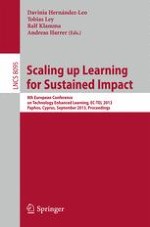This book constitutes the refereed proceedings of the 8th European Conference on Technology Enhanced Learning, EC-TEL 2013, held in Paphos, Cyprus, in September 2013. The 31 full papers, 18 short papers, 14 demonstrations and 29 posters presented were carefully reviewed and selected from 194 submissions. The papers are organized in topical sections. The topics addressed include open educational resources (OER), massive open online courses (MOOC), schools of the future, orchestration of learning activities, learning networks, teacher networks, bring your own device (BYOD), social media, learning analytics, personalization, mobile learning, computer-supported collaborative learning, game-based and simulation-based learning, and learning design.
